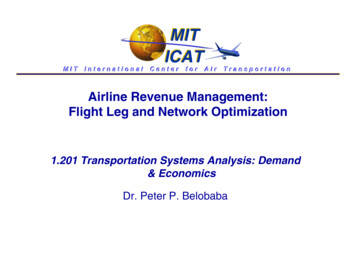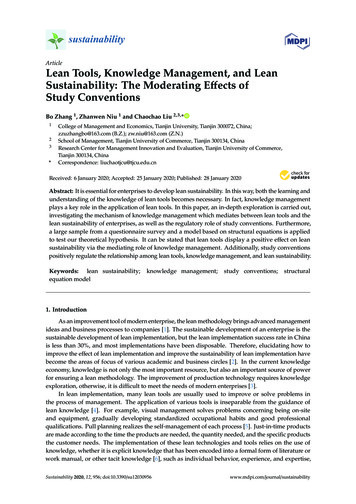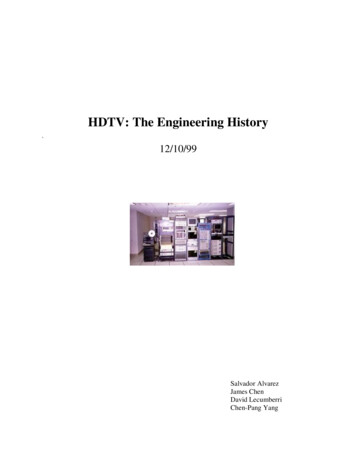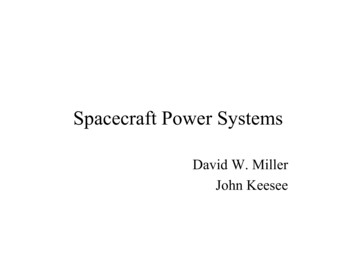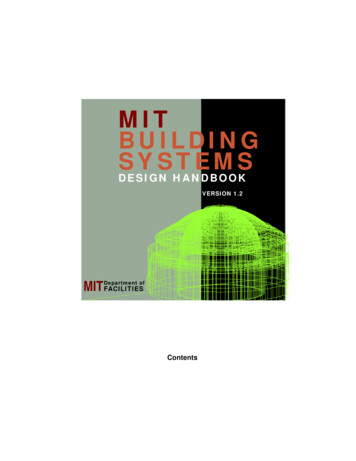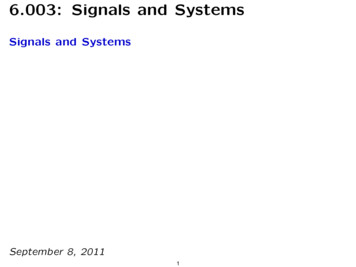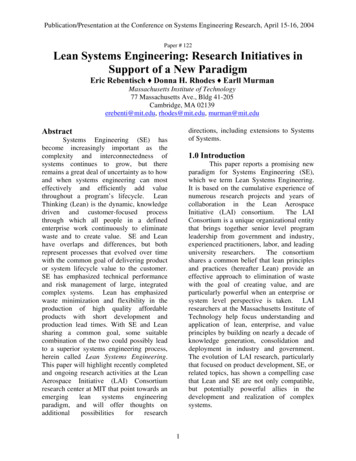
Transcription
Publication/Presentation at the Conference on Systems Engineering Research, April 15-16, 2004Paper # 122Lean Systems Engineering: Research Initiatives inSupport of a New ParadigmEric Rebentisch Donna H. Rhodes Earll MurmanMassachusetts Institute of Technology77 Massachusetts Ave., Bldg 41-205Cambridge, MA 02139erebenti@mit.edu, rhodes@mit.edu, murman@mit.eduAbstractdirections, including extensions to Systemsof Systems.Systems Engineering (SE) hasbecome increasingly important as thecomplexity and interconnectedness ofsystems continues to grow, but thereremains a great deal of uncertainty as to howand when systems engineering can mosteffectively and efficiently add valuethroughout a program’s lifecycle. LeanThinking (Lean) is the dynamic, knowledgedriven and customer-focused processthrough which all people in a definedenterprise work continuously to eliminatewaste and to create value. SE and Leanhave overlaps and differences, but bothrepresent processes that evolved over timewith the common goal of delivering productor system lifecycle value to the customer.SE has emphasized technical performanceand risk management of large, integratedcomplex systems. Lean has emphasizedwaste minimization and flexibility in theproduction of high quality affordableproducts with short development andproduction lead times. With SE and Leansharing a common goal, some suitablecombination of the two could possibly leadto a superior systems engineering process,herein called Lean Systems Engineering.This paper will highlight recently completedand ongoing research activities at the LeanAerospace Initiative (LAI) Consortiumresearch center at MIT that point towards anemergingleansystemsengineeringparadigm, and will offer thoughts onadditionalpossibilitiesforresearch1.0 IntroductionThis paper reports a promising newparadigm for Systems Engineering (SE),which we term Lean Systems Engineering.It is based on the cumulative experience ofnumerous research projects and years ofcollaboration in the Lean AerospaceInitiative (LAI) consortium.The LAIConsortium is a unique organizational entitythat brings together senior level programleadership from government and industry,experienced practitioners, labor, and leadinguniversity researchers.The consortiumshares a common belief that lean principlesand practices (hereafter Lean) provide aneffective approach to elimination of wastewith the goal of creating value, and areparticularly powerful when an enterprise orsystem level perspective is taken. LAIresearchers at the Massachusetts Institute ofTechnology help focus understanding andapplication of lean, enterprise, and valueprinciples by building on nearly a decade ofknowledge generation, consolidation anddeployment in industry and government.The evolution of LAI research, particularlythat focused on product development, SE, orrelated topics, has shown a compelling casethat Lean and SE are not only compatible,but potentially powerful allies in thedevelopment and realization of complexsystems.1
Publication/Presentation at the Conference on Systems Engineering Research, April 15-16, 20042.0 Lean Systems Engineeringshows that many of the activities areinvoked in the earlier stages of a productlifecycle,principallyfromconceptexploration through detailed design.Therefore, while it is the most encompassingof engineering disciplines, SE still retains astrong engineering core identity.Lean emerged from the Japaneseautomobile industry in response to the needto deliver quality products with a minimumuse of resources2. Lean has emphasizedwaste minimization and flexibility in theproduction of high quality affordableproducts with short development andproduction lead times. In the United States,Lean has typically been associated withmanufacturing in general and with theToyotaProductionSystem(TPS)specifically. Womack and Jones3 helped inthe implementation of that system with theirfive steps to implement Lean Thinking,shown in Table 2 below.Neither practitioners nor researchersare likely to associate SE and Lean with oneanother at first glance.SE emergedpredominately from the U.S military andcivil space program in response to the needfor technically demanding systems to workflawlessly upon initial deployment1. Withthis heritage, SE has emphasized technicalperformance and risk management of large,integrated complex systems. Activities andpractices typical of SE are shown in Table 1.Table 1. Typical SE Activities.SE ActivitiesSE TechnicalManagementSystem DesignProductRealizationTechnicalAnalysis mPostImplementationSupportAdapted nt, SE process metrics, TPMs,reviews and auditsRequirements definition and solutiondefinition processesBaseline maintenance, requirements anddesignloops, prototyping, systemintegration, V&VAnalyses Including: deployment, design,environmental impact, human systemsengineering, LCC, manufacturing ntainability/availability,safety and health hazard, ability, system cost/effectiveness,system modeling, system security, tradestudies, training, verification, and disposalconfiguration and data managementTable 2. Five Steps of Lean ThinkingStepSpecify ValueIdentify the ValueStream:standard SE processes and practices,reviews, audits, lessons learned, analysisand change definitionSE support to manufacturing, sustainingengineeringMake Value FlowContinuously:The practices in Table 1 indicate thatSE processes primarily ensure that “nothingfalls through the cracks” in terms oftechnical performance, internal and externalinterfaces, cost and schedule, operationalneeds, regulatory and other requirements.Experience has shown that ignoring any ofthese can lead to difficulties. It is evidentthat SE embodies rigorous methods to assurethat a system or product is developed toperform as expected by the customer. Whilethese SE activities address the entirelifecycle of a product, closer inspectionLet Customers PullValue:Pursue Perfection:DescriptionValue is defined by the end customerThe set of all specific end-to-end andlinked actions, processes and functionsnecessary to transform information orraw materials into the product expectedby the customer, and then provide postdelivery customer support. Actionseither a.) create value; b.) create novalue but are necessary or unavoidable;c.) creates no value and can beeliminated.Action focuses inminimizing non-value added activities.Withnon-valueaddedactivitieseliminated, next all bottlenecks to thesmooth flow of information or materialprocessing (indicated by work-inprocess—WIP) are removed.Leanrelentlessly pursues the elimination ofsuch WIP.Deliver the value when it is expected bythe customer (“just-in-time”), and usethis to “pull” value from all “upstream”activities.Lean is not a “state”, but a “journey” inwhich continual improvement is soughtto make processes better and better—asmeasured by their value delivery.Adapted from (3)As Lean has been embraced morewidely, it has expanded beyond its roots inthe production environment to accommodate2
Publication/Presentation at the Conference on Systems Engineering Research, April 15-16, 2004expanded and more challenging contexts.Murman, et al describe Lean Thinking as thedynamic, knowledge driven and customerfocused process through which all people ina defined enterprise continuously work toeliminate waste and to create value4.There are key differences andsimilarities between SE and Lean that areworth noting. First, both SE and Leanemerged from practice; their respectiveprecepts, principles, and theories werecodified later.SE and Lean havetraditionally focused on somewhat differentphases of the product lifecycle with theirrespective challenges and realities. Thetraditional domain of SE practice isgenerally product development, while thetraditional domain of Lean practice isgenerally production. SE is traditionallyfocused on those activities that lead to thedefinition (from requirements to detailedspecifications) of the product that is mostlikely to successfully meet customer needs.On the other hand, Lean is traditionallyfocused on those activities that lead to therealization of the product that willsuccessfully provide the customer withvalue.With this difference in areas of focusof lifecycle phases, SE has more of anemphasis on planning, while Lean has moreof an emphasis on empirically-driven action.Within the SE context, value might berepresented by a measure of risk (that is, asrisk decreases, value created increases)5. SEprocess activities have been honed to reducethe risk (performance, cost and schedule) oflarge, complex, highly-integrated systems asthe means to create value. In order toaccommodate the intricacies of producing acomplex system that performs as required toprovide the customer with value, SE strivesto create the perfect plan or architecture thathas minimal risk in execution (withattendant processes, tools, structures,artifacts, etc.)On the other hand, in order toaccommodate continuous improvement in acomplex production environment, Leanstrives to enable all stakeholders tounderstand, assess, and improve theirrespective processes, with the expectationthat the entire enterprise will evolve its waytowards perfection. People are central tosuccessful Lean implementation.Leanemphasizes tools and practices that can takeadvantage of the knowledge and skills of allparticipants in the system to reduce waste,poor quality, delays, or unnecessaryinvestment.In the production context,customer value relates directly to productcost, quality, and timeliness.In contrast to Lean, there is relativelyless emphasis in SE on quality principles,empowerment and capability of peopleexecuting process activities, smooth flow ofinformation to eliminate bottlenecks,continuous improvement, or maximizing thevalue added by each process activity.IntegratedProductandProcessDevelopment (IPPD) and Integrated ProductDevelopment Teams, or IPTs, are notableexceptions. It is clear that IPPD and IPTshave brought an important multifunctionalhuman and communication element to SEwith beneficial outcomes. IPPD and IPTsare also central elements of Lean.Despite the important differencesbetween SE and Lean, we believe that thattwo ultimately strive for the same objective,and therefore are compatible and evencritically linked. The domains of SystemsEngineering (SE) and Lean Thinking (Lean)both represent processes that evolved overtime with the common goal of deliveringproduct or system lifecycle value tostakeholders. Generally, one can considerlifecycle value as some combination ofproduct performance, quality, cost, andavailability as defined by customer’s needs4.Because of their different legacies, Lean andSE have emphasized different elements of3
Publication/Presentation at the Conference on Systems Engineering Research, April 15-16, 2004product systems, there is an important rolefor both grass-roots improvement andevolutionary change towards perfection aswell as systemic and architecturalimprovements at the level of the entiresystem or enterprise. More about thisevolution in perspective is captured inMurman, et al4.The scope of research at LAI hasevolved to include many of the enterpriseprocesses that span the product lifecycle,including many of the SE processes that arefound in Table 1. Figure 1 illustrates thescope of recent LAI research over theproduct lifecycle. It is based on a sample of36 recent LAI research projects (primarilygraduate thesis research) selected from wellover 100 LAI studies based upon theirapplicability to the SE lifecycle stages. Theheight of the bars indicates the number ofresearch projects that had noteworthyfindings or implications for that phase of theproduct lifecycle (the vast majority ofresearch projects had such implications formore than one phase of the productlifecycle.)this common goal. But, if the objective of acomplex system is indeed to provide someoptimal or best lifecycle value to a customeror user, then both SE and Lean haveimportant roles to play. The followingsection discusses research that illustrateshow both SE and Lean can play a role increating value in complex systems.3.0 Research Findings LinkingLean and Systems EngineeringResearch at the LAI began some 10years ago focused on the traditional domainof Lean—the production process—appliedin the context of complex aerospacesystems. There was strong and positiveevidence that Lean applied in this settingwasabletoproducesignificantimprovements in process outcomes. Forinstance, the hours required to assemblefloor beams on large commercial aircraftwere reduced by roughly 50% and fixedtooling was virtually eliminated through theuse of Lean practices6. Research in areasoutsideoftraditionalproductionenvironments such as software processautomation showed similar levels ofimprovement when lean principles wereapplied7.A challenge for LAI consortiummembers and researchers came from theobservation (often from a customer vantage)that despite significant evidence of successin process improvement, the overall (i.e.,“flyaway”) cost or quality of many complexaerospace systems was not changingsignificantly. There are a variety of reasonsto explain this outcome, including thenascent and uneven implementation of Leanin the aerospace context in the early years ofthe LAI consortium. Some notable earlyexceptions were the C-17 and JDAMprograms. Nevertheless, it became clear tomany researchers and practitioners alike thatin a complex organizational system thatdesigns, produces, and procures complex# of S tudies A ddres s ing E ac h A reaFigure 1. Recent LAI Research FindingsAcross the Product Lifecycle.3020100ConceptArchitectureDetailed Verification & Production & Operations &Exploration & Preliminary Design &ValidationDeliverySupportDesignDevelopmentFigure 1 provides a rough indicatorof how research focused on Lean has in factaddressed a broad spectrum of complexsystem realization activities. These researchprojects were related to Lean because theyfocused on improving the creation of value4
Publication/Presentation at the Conference on Systems Engineering Research, April 15-16, 2004The front end process value streams fromidea generation to program launch weremapped for 17 organizations, including 9military organizations and 8 commercialorganizations. Additionally, several othermilitary organizations provided backgroundinformation.for the customer and other enterprisestakeholders. Many included value streamthinking or tools as part of the framing ofthe research and/or the empiricalinvestigation. They are linked to SE in thatthe processes studied, and analyzed forimprovementincludedthelifecycleprocesses that are part of the realization ofcomplex products, including many directlyassociated with SE. This Lean research fallssquarely in the domain of SE practice andfound evidence that these practices can beimproved through the application of Lean.Perhaps more importantly, they arebeginning to show cumulatively that higherlevels of performance in the realization ofcomplex systems may require a combinationof both Lean and SE perspectives andpractices. It is impossible to convey in thespace available here that cumulative weightof evidence. However, a few researchprojects have been selected to illustrate howLean and SE have coexisted and mutuallybenefited the research process.Figure 2 Front End Process Framework.Fundamental Business ntProcess FlowFeedbackProcess EnablerThe User Needs/requirements Discovery Process(Prior to a Business Case Decision)Process EnablerPeople and Organizational hatdistinguishedthehigher-performingorganizations from lower-performing onesincluded the use of multiple, structuredmethods to identify requirements for theconcepts; use of prototypes and models togenerate data for tradeoff analyses; andprioritizing product features and establishingexit criteria prior to the launch ions also had organizational andcultural enablers that made a difference,including the use of dedicated, stablemultidisciplinary teams for analysis andconcept development, engagement of seniorleadership throughout the process and indecision gates, and information systems thatallowed decisions to be made based onstrategicandotherwell-definedorganizational criteria. The reward for suchstructured processes was much fewer, butmore manageable (from an organizationalresource and capability standpoint) programstarts than those organizations with lowerperforming front end processes.3.1 The Front End of ProductDevelopmentThis study examined the processesthat make up the so-called “fuzzy front end”of product development and lead to thedecision to launch a program8.Themotivation for the study was prior researchfindings that a significant source of costgrowth in government and commercialaerospace system development programscame from program instability9. Not onlywas a significant program cost growth founddue to requirements problems, but also astrong link between budget instability andpoorly performing front end process.A framework shown in Figure 2 forassessing process maturity was developedbased on an extensive review of past productdevelopment research in the literature, andformed the basis of a benchmarking surveyused to collect process characteristics data.5
Publication/Presentation at the Conference on Systems Engineering Research, April 15-16, 2004commonality. A composite perspective ofthe value stream from development andproduction through operations and supportwas created from the disparate data. Thisresearch identified the impacts of subsystemcommonality over the lifecycle of a complexsystem, which are shown in Figure 3.Those familiar with high-performingfront-end decision processes and particularlystage-gate processes may not be toosurprised by the findings of this study.What is noteworthy here is that severalthemes and processes from SE and Leanwere commingled in this study.Themotivation for this study was classicallyLean: to enable higher program performanceby reducing instability in key inputs(requirements and funding) and to improvethe flow of work (program requirements)through the product development cycle.Value stream mapping played an importantrole in collecting the data to characterizethese organizations’ processes. However,this research is squarely in the domain ofSE, and many of the processes studied areSE processes. The key insight gained byincluding Lean and SE in this one study isthe importance of organizational andmanagement processes to successfuloutcomes in the front end requirementsprocess.Figure 3. The Impact of SubsystemCommonality Over the Product Lifecycle.Higher y complexity in interoperabilitydevelopment educedReducedmaintenanceHighercycle timesparesreworkhoursreliability downtimeDesign ipmentoperatortestingReduced timetimeEconomies ofcompetencyfor source FasterscaleReducedselection solutions oryequipmentWhat this study concluded was thatcommonality made the most sense at thesubsystem level. Examples include motors,hydraulic equipment, antennas, navigationequipment, electronic warfare (EW)equipment, displays, optical equipment,communications equipment, transponders,etc. It makes sense at this level becauserequirements across multiple platforms areeasier to reconcile, common subsystems willimpact the logistics footprint and repairactivities of weapon systems that deploytogether, and subsystems are sufficientlyhigh cost to make it worth the additionalchallenges. Commonality was not felt to beadvantageous at the system level because ofthe difficulty of reconciling differentmission requirements. Overall, the use ofsubsystem commonality was estimated tolower subsystem acquisition costs by 1540%, and to lower annual operations andsupport costs by 20-45%, based on the coststructureofthespecificsystem.Importantly, it can also concentrateknowledgeandexpertiseintheorganizations that specialize to develop,produce, acquire, and support these3.2 Design Implications for MultipleComplex SystemsThis research explored the benefitsof standardization and commonality acrossmultiple complex aerospace systems10. Itwas motivated in part by prior research thathad shown that high-performing Leanautomakers in Japan had successfully usedcommonality as a way to reduce cost andcycle time11. This research added to theprior findings by studying complexaerospace systems, as well as extending thescope of the study beyond the OEMproducer value stream to also include theuser/operator. Twenty one (21) programswere studied, resulting in 8 case studiesbased on data from interviews with 84respondents.Finding comparable data,especially across such a large value stream,was difficult as organizations often don’tconsider, let alone measure the effects of6
Publication/Presentation at the Conference on Systems Engineering Research, April 15-16, 2004guide for the investigation. The LEM is acompendium of LAI research findings,organized in a hierarchical framework of 12overarching lean practices supported byunderlying enabling practices13. In additionto the LEM framework, a value stream viewwas adopted. Ten (10) mission criticalsoftware upgrade programs were studied infour application domains: military avionics,military space ground terminal, lly, 3 detailed case studies onmilitary avionics, commercial auto-pilot,and space ground terminal programs,respectively, were completed.Among the major findings, the studyfound that there were few enterprise-levelmetrics for the end-to-end softwaredevelopment process in place. Even thoughthe objective of these programs was toprovide an operational capability to a largersystem, the processes and stakeholders usedto complete that task were es for assuring that softwarerequirements “meet the end users needs” and“are cost effective” was found to be dividedamong multiple process owners.Notsurprisingly, when measures were taken toprovide continuity of effort, performanceimproved. There was a positive correlationbetweenreductioninunplannedrequirements changes and leadershipinvolvement in both concept definition andrequirements analysis phases as shown inFigure 4Perhaps the most startling aspect ofthe study was the perspective given by thevalue stream research lens. In terms ofoverall cost to deliver the softwarecapability for the military avionics casestudy, roughly half was not attributable tosoftware proper (it involved ancillary itemssuch as sensors, trainers, documentation,etc.). The other half of the design anddevelopment cost was related to software.subsystems, so that they can be more rapidat implementing improvements or newtechnical innovations into a subsystemfamily.A key insight from this research isthat from a customer value perspective,individual aerospace systems often operate,deploy, and sustain in zations. However, since there istypically no single “owner” for thesepackages of systems, it is difficult to makethe kinds of binding decisions acrossmultiple platforms that are needed to adopt acommonality strategy. Moreover, incentivesfor the development of individual systemsoftenfocusonmaximizingtheprogrammatic performance of that systemonly, so accommodating the needs of othersystems is unattractive. In the case of thisresearch, it is apparent that a traditionalapproach to developing a systemarchitecture may not result in the creation ofthe most value and capability for thecustomer. The lifecycle value perspectivefrom Lean and the use of the value streamacross multiple systems and organizationsprovided important perspective into how tomake choices about system architecture incomplex aerospace systems. It providesanother example of Lean and SE bothbenefiting from a perspective combiningthem together in research.3.3 Software Development ValueStreamThisresearchinvolvedacomprehensive look at government andindustry practices for deriving softwarerequirements from system requirements12.The motivation for the study came from LAIconsortium members eager to experienceprocess improvement in the area of softwaredevelopment similar to that seen in otherareas of lean implementation. The LAILean Enterprise Model (LEM) was used as a7
Publication/Presentation at the Conference on Systems Engineering Research, April 15-16, 2004analyze the tradeoffs involved in therealization of complex systems. Gaining thebroad scope of perspectives needed for suchresearch can be a challenging task forindividual researchers and groups.Fortunately for the emerging LeanSE paradigm, the LAI consortium provideda venue that brought together stakeholdersand researchers from a variety ofbackgroundsandproductlifecycleperspectives to form a learning communityat the national level. The length of this paperdoes not permit a detailed explanation ofhow such a consortium can functioneffectively. But our experience indicatesthat this has been a critical element ofundertaking meaningful research on a topicas broad as Lean SE. (see the preface ofMurman, et. al4 for further details)Therearealsonetworkingopportunities for developing and sharing aLean SE perspective within, but notexclusive to LAI. Within LAI, there is theLAI Educational Network that includesuniversities interested in sharing knowledgeabout Lean and related topics. A subset ofthe LAI Educational Network is devoted toexploring Lean SE.Outside of LAI,professional and academic societies havetraditionally provided a venue for poolingexpertise and perspective on challengingissues. These societies may also enable theadvance of the Lean SE paradigm, perhapsthrough focused interest groups.By looking at the entire softwaredevelopment value stream, this study foundthat code generation accounted for onlyabout 6% of the total cost of the deliveredproduct. Much greater costs were associatedwith validation and verification.Unplanned ReqChanges (% est.)Figure 4 – Impact of Leadership Continuityon Concept Definition and RequirementsAnalysis for 9 Software Upgrade Programs.403020100020406080Program Leadership Continuity (%)This study again emphasizes whereboth Lean and SE may play important rolesin creating value for the customer. Many ofthe requirements practices and managementstrategies seen as important to improvingperformance in this study would likely beregarded by some as “good systemsengineering”—underscoring the importanceof SE in performance improvement.Implementing good SE practices without thecustomer value stream perspective mightlead one to make investment in processes(e.g., improving the efficiency of coding)that had minimal effect in the flow of valuethrough the system.5.0 Areas for Future Research.4.0 Lean SE Research EnablersLean SE is an emerging field. Assuch, there is much to learn, even withrespecttoestablishingappropriateboundaries of inquiry for the field.However, in contemplating the fusion of twoestablished knowledge areas, one canimagine at least three general strategies fordeveloping new research streams, basedsimply on permutations of the existing areas.Future research exploring Lean SE,based on the work cited here, will benefit byworking from the respective strengths ofeach knowledge domain. From Lean, thatincludes a stakeholder value perspective thatreaches from the earliest definitions of theproduct through its use in operation. FromSE that includes specific domain knowledgeof the tools and processes used to architectsystems, manage risk, and identify and8
Publication/Presentation at the Conference on Systems Engineering Research, April 15-16, 2004The first stream of potential researchwould involve exploring how traditional SEpractices could become more “lean”.Womack and Jones’ Five Steps to LeanThinking have been widely applied to manyprocesses beyond manufacturing, includingproduct development and engineering,transactional processing, and analysis ofenterprise level activities. It would seemlogical to apply them to systemsengineering. SE guidelines indicate that SEshould be tailored or applied uniquely toeach project. The value principles of Leancould provide a well developed andstructured framework for this, for example,the use of Value Stream Mapping.Applications of Lean to SE could directlybuild upon existing risk managementmethods of SE. Some research efforts atMIT c.f., 5, 14 have aimed at developingquantitative tools for modeling riskmanagement and risk reduction in productdevelopment. Often people ask “how muchsystems engineering is needed” for aparticular project. The goal of Lean SystemsEngineering would be to answer thisquestion with a structured approach whichdelivers the best value to the end customerin terms of system performance, cost andschedule—all with a focus on acceptablerisk.The second potential stream ofresearch would be to make Lean moresystems-oriented. SE provides a structuredmethod for managing the requirements,system elements, interfaces, validation, andoperational analysis of complex systems.Traditional Lean has often been applied inan opportunistic fashion. Is there somebenefit to using the structured methods ofSE to provide a more systematic direction tothe deployment of Lean in a complexenterprise? Can SE analytical methodsprovide insight into how best to select andevolve a Lean enterprise structure? Canlean organizational processes be assessed forrisk and tailored so as to be robust topotential instabilities in their operations orenvironment?Some work is alreadyunderway to address questions in thisresearch stream through
Lean has emphasized waste minimization and flexibility in the production of high quality affordable products with short development and production lead times. With SE and Lean sharing a common goal, some suitable combination of the two could possibly lead to a superior systems engineering process,
